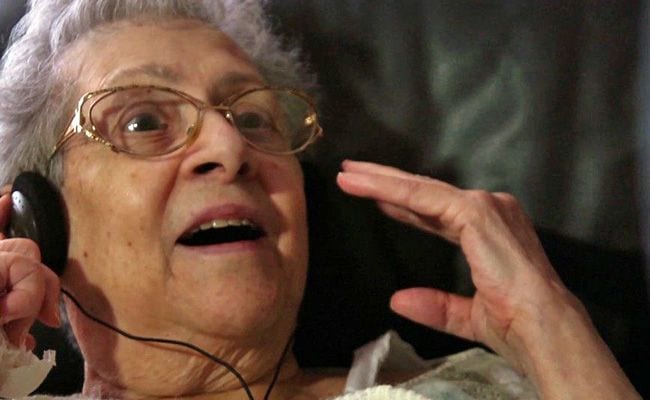
“She says we just don’t understand. I think that’s probably true.” As Doug describes what he guesses his wife Marylou must feel, living with Alzheimer’s, you see him help her put on her jacket. “You end up being dependent on someone else for everything that you do. You can no longer write your name, you struggle reading, you lose small motor control. You can’t even remember how to get in and out of your apartment, or the elevator.” Here Alive Inside illustrates his story, the camera following behind Marylou as she walks to the elevator and can’t tell which button to press to go down. When she does press the right button, she wonders whether she’s done it “badly”.
As Doug suggests, we probably don’t understand. But in these brief images, Michael Rossato-Bennett’s documentary offers an idea. Watching Marylou, you can’t know if she’s frustrated or fretful, appreciative or self-aware. You do gather that the world can seem confusing, as the mobile, mostly close frame indicates in its shifts and turns, the possibility you might not know quite what’s around a corner that sort of looks familiar.
What we can understand, and what the film makes clear repeatedly, is that aging, losing your memory, or dealing with a physically debilitating illness is hard. And it’s harder when — unlike Marylou — you don’t have someone to look after you, if your option is a nursing home. And while Marylou is at a stage where she can express herself to Doug, other individuals here cannot.
The movie suggests their despair, their isolation and withdrawal, in images that speak for them: they appear in wheelchairs, in common rooms slumped in their chairs, in their beds, turned away from the camera. Per its title, however, Alive Inside also suggests they do have memories and experiences and responses to stimuli, if only they’re offered the chance, beyond the warehousing offered by US nursing homes.
Primarily and specifically, that chance is music. According to Dan Cohen, the social worker, activist, and founder of Music & Memory whom Rossato-Bennett follows for three years, music, especially music that evokes individuals’ pasts, helps people recover themselves. “I don’t know how to say it,” declares Marylou, after you’ve seen her dance and smile and wave her arms to the Beach Boys in her headphones. And then she does say it: “It can’t get away from me, when it’s in this place.”
The movie spends time explaining what you see. Sometimes experts offer not-so-scientific generalizations (“Music has more ability to activate more parts of the brain than any other stimulus,” says Oliver Sacks) or anti-institutional arguments (Bill Thomas asserts, “What we’re spending on drugs that mostly don’t work dwarfs what it would take to deliver personal music to every nursing home resident”). And sometimes the film ensures your understanding, illustrating what one of these experts says with archival footage, in poignant slow motion or nostalgic herky-jerkiness, images alternately sentimental and allusive. These are less vibrant than footage of people now. These images record their vivid, apparently immediate responses, dancing and singing with music, their eyes wide, their hands animated, their motion unstoppable.
Such motion is a sign of how “alive” they feel, and also a visual means for you to feel with them. Most often the film shows people experiencing music, as they sit in their nursing home rooms, dance in a wheelchair or, in the case of Denise, push away her walker and sway, inviting Dan to dance with her. “Did you like music when you were young?” Dan might ask. “What’s your favorite song?” Rossato-Bennett asks questions as well, as he wonders why it’s apparently so difficult for such facilities to provide music, sometimes despite caregivers’ good intentions.
As you watch all the good responses to the music you wonder, too. While the film makes a compelling case against nursing homes — as a concept (a mix of the poorhouse and a hospital, where people become patients), a history (the film traces an evolution, a loss of family connectedness, a fear of aging that turns into a desire to hide old people away). It’s not a new argument, though it can’t hurt to be reminded, however generically
This reminder is not as poetic or profound as the film’s allusions to the ways that memory shapes identity, affords temporal continuity or allows communication with others. And it’s not so hopeful and affecting as the images of nursing home residents who are, however briefly, helped to feel “alive” by being reminded of themselves through listening to music, helped to feel themselves again. At its end, the film offers multiple images of viewers watching images from the film on YouTube, viewers who might, like you, be inspired to provide someone you know with music, even to share time and music with them.
Beyond encouraging such a touching individual moment or generous inclination, the movie’s argument is crucial to understand. It’s too easy to forget people, to leave them in institutions and medicate them out of themselves. It’s a system in need of broad revisions, structural, economic, and philosophical.


![Call for Papers: All Things Reconsidered [MUSIC] May-August 2024](https://www.popmatters.com/wp-content/uploads/2024/04/all-things-reconsidered-call-music-may-2024-720x380.jpg)



